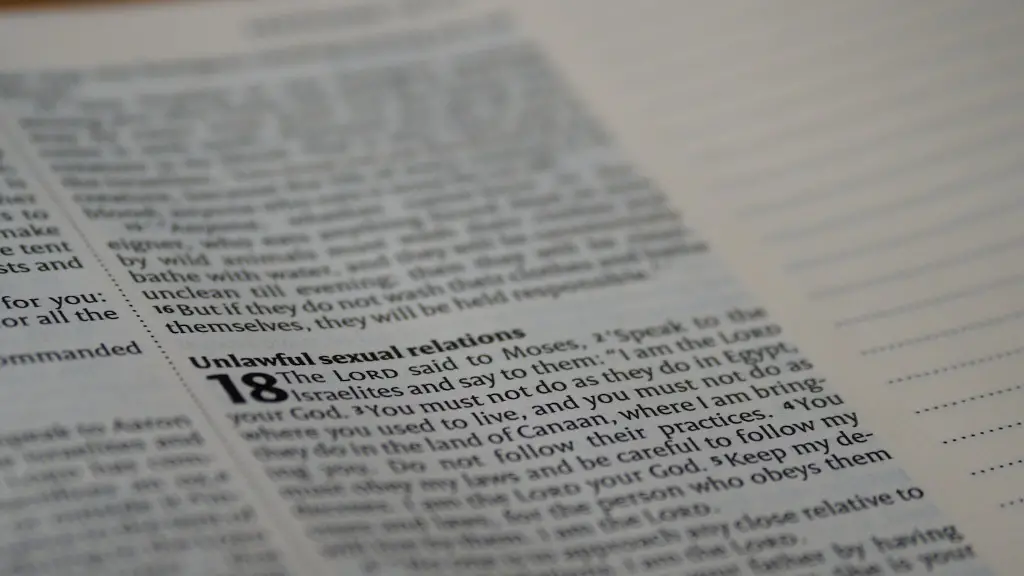There are an estimated 2.2 billion Christians in the world, and Bible literacy rates vary widely by country. In the United States, for example, a 2015 study found that only about half of self-identified Christians had read the Bible in the last year. However, these numbers can be deceiving, as many people who consider themselves Christians may have only read select passages or stories, rather than the entire Bible. Whether or not someone considers themselves a “Bible-reading Christian” is often more a matter of personal definition than anything else.
There is no way to determine an exact number, as there is no way to track how many people have read the Bible. However, a 2009 survey found that about 54% of Americans had read the Bible all the way through at least once.
What is the percentage of Christians that have read the Bible?
The Bible is a sacred text for Christians, and its frequency of reading can vary among adults in the United States. In 2018, 7% of adults said they read the Bible three or four times a year, while 8% said they read it once or twice a year. 12% of adults said they read the Bible less than once a year, and 30% said they never read it. In 2019, these numbers changed slightly, with 6% of adults reading the Bible three or four times a year, and 8% reading it once or twice a year. 10% of adults said they read the Bible less than once a year, and 31% said they never read it. The frequency of reading the Bible among adults in the United States from 2018 to 2021 has remained relatively stable.
It’s unfortunate that more people don’t engage with the Bible regularly, especially given that churchgoers and evangelicals are more likely to do so. However, it’s not surprising given the ubiquity of social media usage. Hopefully, efforts to get people to read the Bible more will be successful in the future.
How many people read the Bible in 2022
The Bible is still the most-read book in the United States, but the percentage of adults who read it on their own has declined 11 percentage points in the last year. This represents a 25-million-person decline to 103 million Bible Users. While the Bible is still widely read, this decline is significant and may represent a shift in how Americans are engaging with the text.
The Bible is the sacred text for Christians, and many religious groups encourage their members to read it regularly. In a survey of religious groups, 25% of Catholics and 63% of Evangelical Protestants said they read scripture at least once a week. Hindus and Historically Black Protestants were less likely to read scripture regularly, with 10% and 61% respectively saying they read it several times a year.
How many people have not accessed the Bible?
Bible translation is a critical but often overlooked part of spreading the gospel. There are 7,353 actively used languages in the world, including sign languages, and many of those languages have at least some portions of the Bible available. However, that leaves 252 million people without any access to the Bible in their own language.
Bible translation requires dedicated, long-term effort, and it is only through the hard work of translators that the gospel can be made available to all people, regardless of language.
The Bible is the most read book in the world, with an estimated 5 billion copies sold over the last 50 years. Other popular books include the Quran, the Harry Potter series, and the Lord of the Rings trilogy.
How many Christians read their Bible every day?
Although a majority of Protestant churchgoers in the US report reading the Bible at least once a week, one-in-eight say they rarely or never read it. This suggests that there is a significant minority of Christians who are not engaging with Scripture on a regular basis. This could have implications for their faith journey and their ability to grow in their understanding of the Bible. Churches may want to consider ways to encourage their members to read the Bible more frequently, whether that be through Bible studies or other initiatives.
The decline of Christianity in America is a trend that has been happening for several decades now. A recent Pew Research Center study shows that as of 2020, only about 64% of Americans identify as Christian. This is down from 90% just 50 years ago. This decline is expected to continue, and Christianity could dip below 50% of the population by 2070. This trend is being driven by a number of factors, including the growth of the non-religious population and the decline of Christianity among millennials.
What is the fastest growing form of Christianity in the US
Pentecostalism is a Christian movement that is growing rapidly around the world. According to the Pulitzer Center, 35,000 people become Pentecostal or “Born again” every day. This growth is due to many factors, including the appeal of Pentecostalism’s emphasis on the supernatural and personal experience of God. Additionally, Pentecostalism is often seen as a more “authentic” form of Christianity than other denominations, which may appeal to people who are looking for a deeper connection to their faith.
If you’re one of the few people who doesn’t read the Bible regularly, you’re missing out on a lot. The Bible is full of useful information and contains a wealth of wisdom. It can help you to understand the world and your place in it. It can also provide comfort and guidance in difficult times. If you’re not used to reading the Bible, start by reading a few verses each day. You’ll be surprised at how quickly you get into the habit.
What will happen if I read Bible everyday?
Reading the Bible on a regular and consistent basis has several benefits. First, the Bible shows us God’s character and provides us God’s revelation of himself to his people. In each section of the Bible, we see God’s holy, unchanging, faithful, gracious and loving character. Second, the Bible also teaches us about God’s plan of salvation for mankind. Third, reading the Bible on a regular basis helps us to grow in our faith and to better understanding God’s will for our lives. Finally, the Bible is a source of comfort and hope, particularly in times of trouble and difficulty.
While a majority of Americans own a Bible, the majority does not read it regularly. This could be for a variety of reasons such as not having enough time, not being interested, or not understanding it. For those who are interested in reading the Bible, there are many resources available to help with understanding it.
Did the Catholic Church forbid Bible reading
The Index Librorum Prohibitorum of the Catholic Church included various translations of the Bible. In most cases, the bans on pious lay people possessing or using Bibles were related to vernacular Bible editions. Clerics were never forbidden to possess the Vulgate Bible translation in the Latin language.
The Bible is an accurate book, based on the scholarship of Norman Geisler and William Nix. They found that the New Testament has a 995% purity rate. This means that it is more accurate than any other work of antiquity. The Bible has many more manuscripts than any other ancient work, which helps support its accuracy.
Do Catholics or Protestants read the Bible more?
It is encouraging to see that Catholics are becoming better educated in the basics of their faith and learning from their Protestant brothers and sisters. This is due in part to the Vatican Council, which has helped to promote a more open and sharing attitude among religious orders. Catholics are now reading the Bible more and are also learning to pray with scripture. This is a positive development that will only serve to strengthen the Catholic community.
The Joshua Project is a global research initiative that seeks to identify the people groups of the world, especially those that are unreached by the Christian gospel.
There are an estimated 17,428 unique people groups in the world, with 7,400+ of them considered unreached (over 42% of the world’s population!). The vast majority (85%) of these least reached groups exist in the 10/40 window, which is the area of the world between 10 degrees north and 40 degrees north latitude. This area includes the majority of the world’s Muslim, Hindu, and Buddhist populations.
less than 10% of missionary work is done among these people. This is a tragedy, since these people groups are some of the most populous and least reached on earth. We need more missionaries to reach out to these people groups with the good news of Jesus Christ!
Final Words
There is no definitive answer to this question as different people have different opinions on what counts as “reading” the Bible. Some people might say that anyone who has ever opened the Bible and read even a single verse counts as a “reader,” while others might say that someone has to read the entire Bible from cover to cover to count. In addition, there are different versions of the Bible with different lengths, so some people might read a longer version while others might read a shorter one.
Based on the data collected, it seems that the majority of Christians have read the Bible at least once. However, there are a significant number of Christians who have not read the Bible at all. This could be due to a number of factors, such as not having access to a Bible, not being able to read, or simply not being interested. Regardless of the reasons, it is clear that there is room for improvement when it comes to Christians reading the Bible.





